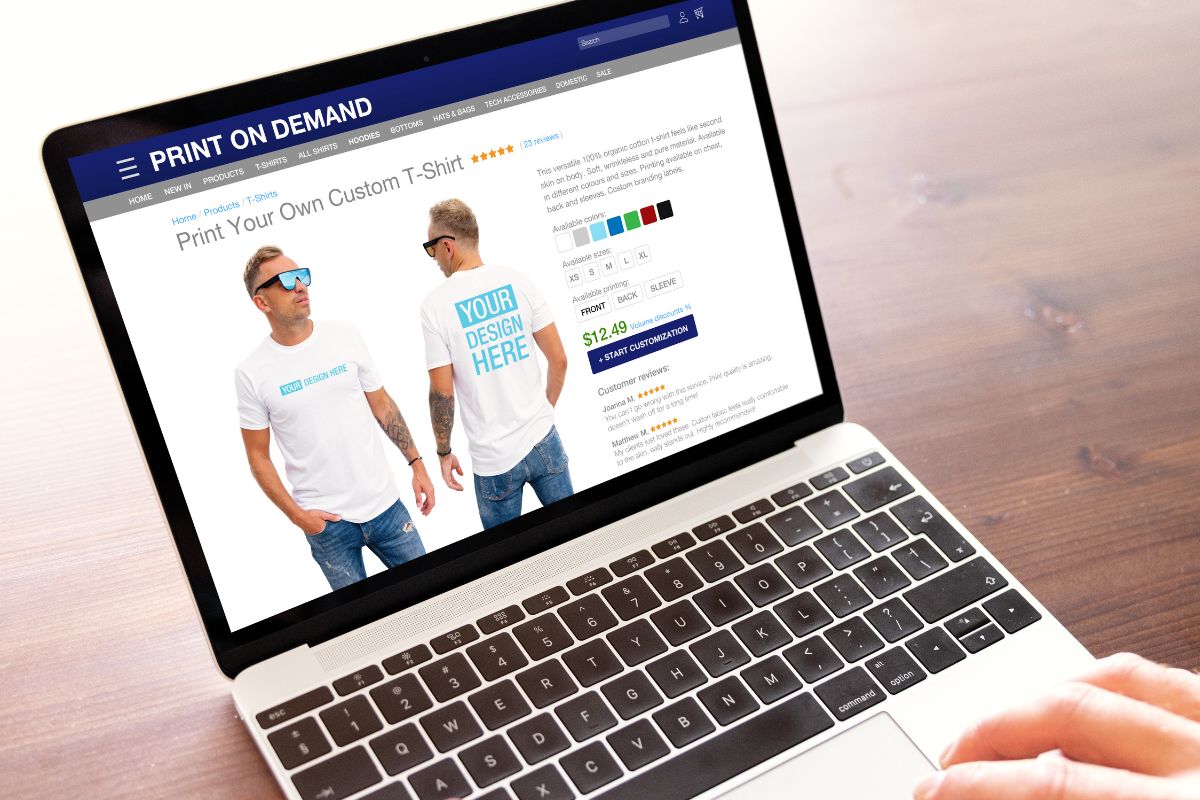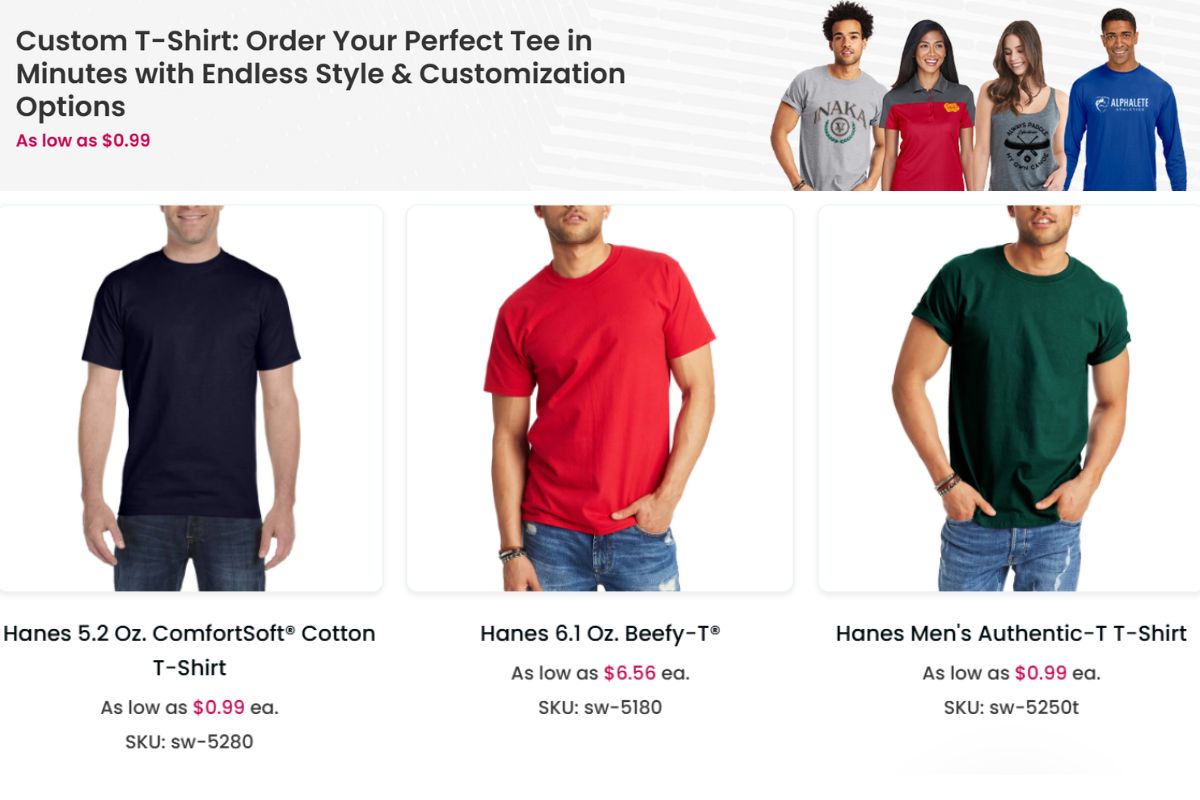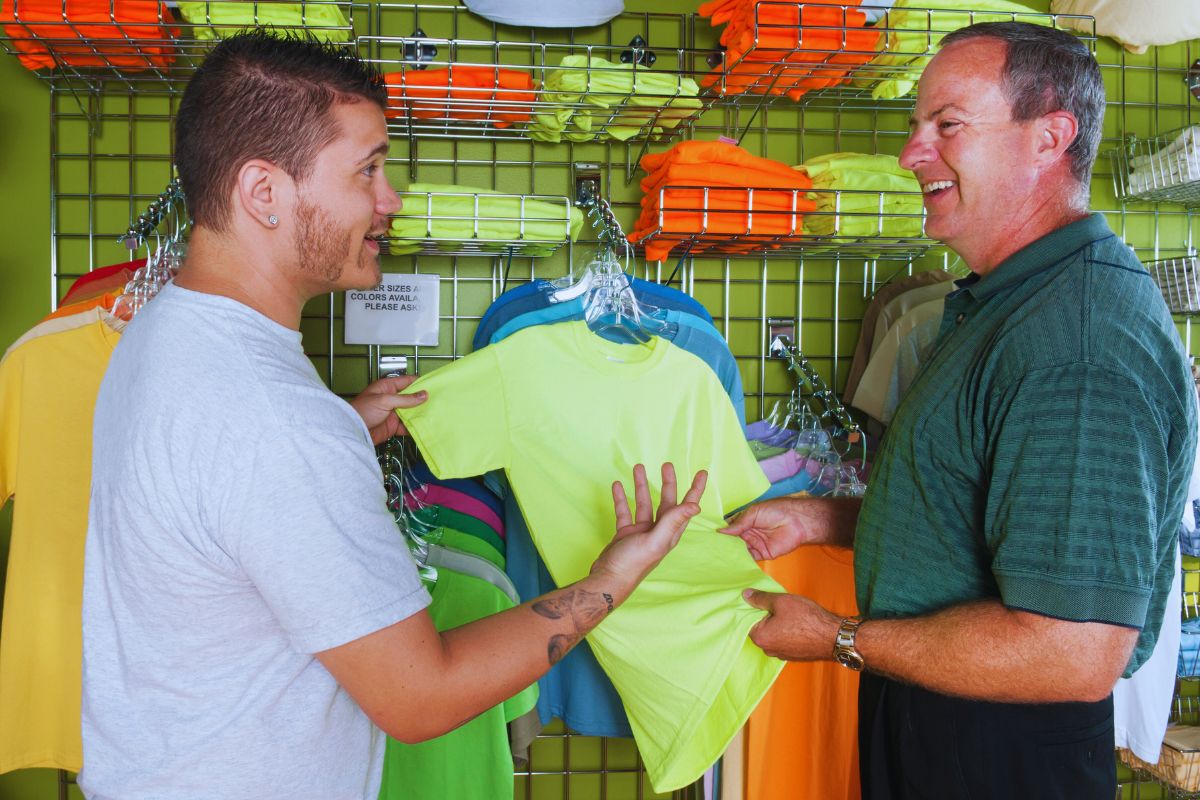If you want to start selling t-shirts online, choosing the right platform is essential for your success.
Amazon stands out as the best place to sell shirts online, thanks to its immense traffic and established customer base.
With millions of people visiting each month, listing your designs here can lead to significant exposure and sales.
Table of contents
- Understanding the T-Shirt Market
- Key Factors to Consider:
- Choosing the Right Ecommerce Platform
- Creating Your Online Store
- Designing Your T-Shirts
- Production and Fulfillment Options
- Marketing Your T-Shirts
- Selling on Marketplaces
- Maximizing Profits
- Providing Excellent Customer Support
- Expanding Your T-Shirt Business
- Frequently Asked Questions
- How can I start selling t-shirts online with no inventory?
- What are the most profitable platforms for selling t-shirt designs?
- Which website is the best for creating and selling custom t-shirts?
- Can you make a significant profit by selling t-shirts on Amazon?
- What strategies should I employ to sell t-shirts effectively online?
- Is Etsy a good marketplace for selling unique t-shirt designs?
Other notable options include Printify and Printful, which offer easy setup and allow you to sell custom t-shirts through print-on-demand services.
These platforms don’t require inventory, letting you focus on creativity rather than logistics.
You might also want to consider Spreadshop for a completely free option, letting you create your own online shop without upfront costs. Each of these platforms has unique features, giving you various ways to turn your t-shirt designs into profit.
Understanding the T-Shirt Market
The t-shirt market offers vast opportunities for you. Many people buy t-shirts for fashion, events, or personal expression.
Key Factors to Consider:
- Target Audience: Knowing who will buy your shirts is crucial. Think about age, interests, and style preferences.
- Niche Market: Focusing on a specific niche can help you stand out. For example, consider themes like pets, fitness, or pop culture.
- Competition: The online t-shirt market is competitive. Large platforms, like Printify and Etsy, are popular. They attract many sellers and buyers. Understanding what makes your t-shirts unique will help you compete better.
- Setting Up Your Online Store: Choose a platform that fits your needs. Some options include:
- Etsy: Great for handmade and unique items.
- Printify: Ideal for print-on-demand services.
- Marketing Your T-Shirts: Once your store is set up, effective marketing is vital. Use social media to reach your audience. Display your designs and share your story. Engaging with potential customers can build loyalty.
Choosing the Right Ecommerce Platform
| Platform | Pros | Cons |
|---|---|---|
| Shopify | Full control over branding, customizable store, integrates with print-on-demand (POD) services like Printful & Printify. | Monthly fees, requires marketing efforts to drive traffic. |
| Etsy | Large audience for handmade/custom T-shirts, low listing fees, trusted marketplace. | High competition, transaction fees, limited customization. |
| Amazon Merch on Demand | Massive customer base, no upfront costs, Amazon handles printing/shipping. | Competitive, limited design control, strict approval process. |
| Redbubble | No upfront costs, global audience, handles printing and shipping. | Lower profit margins, limited branding options, high competition. |
| TeeSpring (Spring) | No upfront costs, built-in audience, integrates with social media platforms. | Limited control over pricing, lower profit margins. |
| Printify | Wide range of printing partners, integrates with Shopify, WooCommerce, and Etsy. | You handle customer service, requires a storefront (Shopify, Etsy, etc.). |
| Spreadshirt | Customizable storefront, marketplace exposure, no upfront costs. | Lower traffic than Amazon/Etsy, commission-based earnings. |
| TeePublic | Large marketplace, free to use, hands-off fulfillment. | Lower profit margins, marketplace control over pricing. |
| Zazzle | Customizable products, built-in audience, passive income potential. | Lower profit margins, limited marketing control. |
| WooCommerce | Full control, no marketplace fees, integrates with POD services. | Requires a website and hosting, more setup effort needed. |
Choosing the right ecommerce platform is crucial for your online t-shirt business. The right platform will help you attract customers and maximize sales.
You should evaluate key features, compare costs, and assess ease of use before making a decision.
Evaluating Key Features
When selecting an ecommerce platform, focus on essential features. Look for inventory management for tracking your t-shirt stock. Customization options are vital, allowing you to design your store to fit your brand.
Consider platforms like Shopify, which offer integrated marketing tools to promote your products effectively.
WooCommerce gives you flexibility, especially if you already use WordPress. Evaluate whether the platform supports print-on-demand services to handle orders easily. A strong user interface can also enhance the shopping experience for your customers, leading to higher sales.
Comparing Platform Costs
Each ecommerce platform has a unique cost structure that affects your profit margins. For instance, Shopify has a monthly subscription that varies based on the plan you choose. More advanced plans offer lower transaction fees and additional features, which may save you money as your business grows.
Wix offers a more affordable option, especially for beginners, with various pricing plans that include hosting.
WooCommerce is technically free but requires a hosting service, which adds costs. Factor in transaction fees and payment processing charges when comparing platforms, as these can significantly impact your bottom line.
Assessing the Ease of Use
Ease of use is another key factor in choosing an ecommerce platform. A user-friendly interface helps you set up your online store quickly. Look for drag-and-drop features, which simplify the website design process.
Shopify is often praised for its intuitive dashboard, making it easy to manage your products and orders.
Wix offers a straightforward setup, ideal for those with limited technical skills. Consider the learning curve for WooCommerce, which may be steeper if you are new to website building. The right platform should allow you to focus more on selling and less on technical difficulties.
Creating Your Online Store
Building your online store involves several key steps that help you attract customers and manage sales effectively.
You will need to focus on how to customize your shop, understand fees, and set up payment processing.
Customization and Branding
When setting up your online store, customization plays a crucial role. Platforms like Shopify offer various options to help you design a unique brand identity. You can choose themes, colors, and fonts that match your vision.
Consider adding your logo and creating a cohesive look throughout your store. You can also personalize product descriptions and images. This helps potential buyers trust your brand.
Don’t forget about social media integration. Link your store to platforms like Instagram and Facebook. This strategy helps you reach more customers and enhances your marketing efforts.
Listing and Transaction Fees
Before launching your store, it’s essential to understand the costs involved. Most platforms have listing fees for each product you upload. For example, Shopify charges a monthly fee, while additional platforms may have varying rates.
Transaction fees are another consideration. These fees occur when a customer makes a purchase. Fees can range from around 2% to 5%, depending on the payment processor you choose. Compare these costs among different platforms to find the best option for your budget.
Be mindful of promotions or discounts. Offering a sale can attract buyers, but make sure you calculate how fees will affect your profits.
Setting Up Payment Processing
To sell t-shirts, you’ll need a reliable payment processing system.
Setting up a PayPal account is a popular option, as it’s widely accepted and user-friendly. You can also look into options like Stripe, which integrates smoothly with many online store platforms.
Ensure that your payment processor allows for secure transactions. This is crucial for customer trust. Display security badges on your site to reassure buyers.
Take the time to test your payment setup. Make a few test transactions to ensure everything works smoothly. This step helps avoid issues when customers are ready to buy.
Designing Your T-Shirts
| Step | Details | Key Considerations |
|---|---|---|
| 1. Choose a Design Style | Decide on graphic, typography, minimalist, vintage, or artistic styles. | Align with your target audience and brand identity. |
| 2. Use Professional Design Tools | Create designs using Adobe Illustrator, Photoshop, or free tools like Canva. | Ensure high-resolution (300 DPI) and vector files for quality printing. |
| 3. Select a Printing Method | Options include Screen Printing, DTG (Direct-to-Garment), Heat Transfer, and Sublimation. | Screen printing is durable but costly; DTG is flexible for small orders. |
| 4. Pick the Right Fabric & Material | Cotton, polyester, and blends affect comfort and print quality. | Cotton is breathable; polyester is moisture-wicking. |
| 5. Choose Print Placement | Front, back, sleeves, pocket prints, or all-over designs. | Placement impacts visual appeal and production cost. |
| 6. Test Designs on Mockups | Use tools like Placeit, Smartmockups, or Photoshop to visualize designs. | Helps in marketing and getting customer feedback before production. |
| 7. Ensure Print Compatibility | Convert designs to CMYK color mode and check transparency levels. | Some colors may print differently than they appear on screen. |
| 8. Get Feedback Before Launch | Share designs on social media or survey potential customers. | Helps refine designs based on audience preferences. |
| 9. Consider Seasonal Trends | Design collections based on trends, holidays, or viral topics. | Limited-edition releases create urgency and boost sales. |
| 10. Work with Professional Designers | Hire freelance designers on Fiverr, Upwork, or 99designs if needed. | Ensures high-quality, original artwork. |
Creating a standout t-shirt design involves careful consideration of graphic design elements and current trends in custom apparel. Focusing on these aspects can help ensure your designs resonate with potential customers.
Graphic Design Elements
When designing your t-shirts, consider key graphic design elements that will elevate your custom t-shirt designs.
Start with colors; choose a palette that reflects your brand identity. Colors can evoke feelings and attract different audiences.
Next, think about typography. The style and size of text can make or break a design. Ensure your chosen fonts are legible and fit the overall aesthetic.
Images or illustrations should be high-quality and relevant to your theme. Utilize mockups to visualize how your designs look on actual shirts.
Lastly, consider balance and alignment. Your design should feel cohesive, with elements distributed evenly to create a professional look.
Custom Apparel Trends
Staying updated on custom apparel trends helps your designs appeal to buyers.
Right now, sustainability is a major focus. Many consumers prefer eco-friendly materials, so consider using organic cotton or recycled fabrics in your designs.
Another trend is minimalism. Simple designs with limited colors or elements can be very effective. This style is often easier to produce and can appeal to a broader audience.
Incorporating personalization is also popular. Customers enjoy the option to customize their shirts. You can offer different colors, sizes, or even personalized text.
Lastly, pay attention to graphics that reflect current pop culture, such as memes or standout imagery. These can drive engagement and attract younger consumers.
Production and Fulfillment Options

When selling t-shirts online, choosing the right production and fulfillment method is crucial. You can opt for print-on-demand services or traditional printing methods. Understanding these options helps you manage costs, quality, and delivery times effectively.
Understanding Print-on-Demand
Print-on-demand (POD) technology allows you to create and sell custom t-shirts without holding any inventory. With POD, your designs are printed only after a customer places an order. This reduces the risk of unsold products while optimizing cash flow.
Common advantages of POD include:
- Low Startup Costs: You avoid large upfront expenses.
- Automatic Order Fulfillment: Many POD services handle printing and shipping for you.
- Design Flexibility: You can quickly change designs based on trends without waste.
Popular print-on-demand services include Printful and Redbubble, which offer easy integration with online stores.
Choosing a T-Shirt Printing Service
Selecting the right t-shirt printing service is essential for quality and reliability.
Consider factors such as:
- Printing Techniques: Look for services that offer high-quality printing methods, such as DTG (Direct-to-Garment) or screen printing.
- Shipping Times: Assess the speed and cost of shipping options to ensure timely delivery.
- Production Costs: Compare rates to find a service that aligns with your pricing strategy.
A good service should also provide a user-friendly platform for uploading designs and managing orders. Research customer reviews to gauge reliability and service quality.
Marketing Your T-Shirts

Marketing your t-shirts effectively is crucial to attract buyers and increase sales.
Focusing on a solid strategy, making use of social media, and utilizing email marketing can set you apart from the competition.
Building Your Marketing Strategy
Start by identifying your target audience. Think about their age, interests, and shopping habits. This will help you create designs that appeal directly to them.
Next, outline your marketing goals. Are you looking to build brand awareness or drive sales? Set clear, measurable objectives. For example, aim to gain 500 followers on Instagram within three months or increase website traffic by 20% in a month.
Consider using a mix of channels. This can include social media, search engine optimization (SEO), and paid advertising. Tailor your message to fit each platform to maximize engagement.
Leveraging Social Media
Social media is a powerful tool for promoting your designs.
Start by choosing platforms where your audience spends time, like Instagram, Facebook, or TikTok.
Create engaging posts that showcase your shirts. Use high-quality images and fun captions. You can also utilize stories and reels for more dynamic content.
Consider hosting giveaways to boost engagement and attract new followers.
Utilize hashtags to increase visibility. Research popular tags in your niche and incorporate them in your posts. This can drive traffic to your profile and product links. Engaging with your audience through comments and direct messages can help build a loyal community.
Utilizing Email Marketing
Email marketing is another essential strategy.
Build an email list by offering incentives, like discounts or exclusive designs. This encourages visitors to sign up for your newsletter.
Once you have a list, send regular updates about new designs, promotions, or events. Craft catchy subject lines to improve open rates. Include clear calls to action in your emails, such as “Shop Now” or “Get Your Discount.”
Segment your email list based on customer behavior. For example, send targeted emails to customers who previously purchased shirts or interacted with your brand. This personalization can lead to higher engagement and conversions.
Selling on Marketplaces
| Marketplace | Pros | Cons |
|---|---|---|
| Amazon Merch on Demand | Huge customer base, Amazon handles printing & shipping, no upfront costs. | Highly competitive, limited design control, strict approval process. |
| Etsy | Ideal for custom and handmade designs, low upfront costs, built-in audience. | High competition, transaction fees, requires marketing effort. |
| Redbubble | No upfront investment, global reach, easy to list designs. | Lower profit margins, limited branding, pricing controlled by platform. |
| TeePublic | No setup costs, passive income potential, large audience. | Low artist earnings, price discounts set by platform. |
| Spreadshirt | Offers customizable storefronts, print-on-demand fulfillment. | Lower organic traffic than Amazon/Etsy, commission-based earnings. |
| Zazzle | Customizable designs, passive income, royalty-based earnings. | High competition, lower control over customer interaction. |
| TeeSpring (Spring) | No inventory needed, integrates with YouTube & social media. | Profit margins depend on pricing, limited marketplace exposure. |
| eBay | Large customer base, allows custom pricing, easy to list products. | Shipping & fulfillment must be managed, listing fees apply. |
| Printify (via Shopify, Etsy, WooCommerce) | Choose print providers, set your own prices, control branding. | You handle customer service, requires additional platform for selling. |
| Society6 | Built-in audience for artistic designs, passive income model. | Limited product control, lower profit margins. |
Marketplaces offer a variety of platforms where you can sell your t-shirts online. Each has its unique audience and strengths, making it important to choose the right one for your designs.
Etsy and Handcrafted Markets
Etsy is a top choice for selling t-shirts, especially if your designs focus on unique or handcrafted elements. With over 92 million active buyers, it is a great place to reach customers who value individuality.
You can set your pricing and handle your branding while connecting with buyers looking for something special.
Other similar markets include Redbubble and Teepublic, which cater to artists and independent creators. These platforms allow you to upload your designs and they handle production and shipping, making it easier for you to focus on your creative work.
Mass Marketplaces like eBay
eBay is a mass marketplace known for a wide range of products, including t-shirts. Selling on eBay gives you access to a global audience. It’s suitable for different styles, from casual wear to vintage designs.
You can choose fixed prices or auction options. The platform allows you to test different pricing strategies to see what works best for your items.
Keep in mind that competition is high, so high-quality images and engaging listings are essential to attract buyers.
Dedicated Clothing Platforms
Dedicated clothing platforms like Spreadshirt and Merch by Amazon are designed specifically for apparel sales. Spreadshirt allows you to create and sell t-shirts under your brand while providing tools for marketing and sales tracking.
Merch by Amazon offers a massive customer base with the ease of Amazon’s trusted service. You can upload your designs, and they handle printing and shipping.
These platforms usually come with lower startup costs compared to traditional retail, allowing for potential profits through print-on-demand services.
Maximizing Profits

To run a successful t-shirt business, you need to focus on two main areas: calculating profit margins and understanding royalties and commissions. Both are crucial for ensuring that you make money online and optimize your sales strategy.
Calculating Profit Margins
Calculating profit margins helps you understand how much money you make after expenses.
Start by determining the cost of each t-shirt. This includes production costs, shipping, and any platform fees.
Use the formula:
Profit Margin = (Selling Price – Total Cost) / Selling Price x 100
For example, if your t-shirt sells for $25 and costs you $14 to produce, your profit margin would be:
Profit Margin = ($25 – $14) / $25 x 100 = 44%
Aim for higher profit margins by adjusting your selling prices. Research competitor prices to stay competitive without sacrificing your profits.
Offering bundles or discounts for multiple purchases can also attract more buyers and increase overall profit.
Navigating Royalties and Commissions
When selling t-shirts online, be aware of royalties and commission rates that affect your profits. Different platforms may have varying fees.
For instance, Etsy charges around 5% on each sale, while Printify takes a portion based on production costs.
Always read the fine print before choosing a platform. Some services may offer free listings but charge high commissions.
To maximize your earnings, factor these costs into your pricing strategy.
For example, if your t-shirt costs $14 to produce and you sell it for $25, subtract any platform commission to find your actual profit.
Keeping track of these figures helps you set realistic financial goals and avoid surprises when calculating your net income.
Providing Excellent Customer Support

Providing strong customer support is crucial for your online shop. It helps build trust and encourages repeat business.
Here are some key strategies to consider:
Be Responsive: Respond to inquiries quickly. Aim for a response time of a few hours, not days. A quick reply shows you value your customers.
Use Multiple Channels: Offer support through various channels. This includes email, live chat, and social media. Each customer has their preferred method of communication.
Train Your Team: If you have a team, ensure they are well-trained. They should know your products and policies inside and out. This helps them assist customers effectively.
Utilize Online Surveys: After a purchase or interaction, send a brief survey. This can help you understand customer satisfaction. Use the feedback to improve your service.
Address Issues Promptly: If a customer has a problem, deal with it quickly. A swift resolution can turn a negative experience into a positive one.
Create a FAQ Page: Having a frequently asked questions page can help customers find answers fast. This reduces the number of inquiries you receive.
Show Appreciation: Thank customers for their patience and feedback. A simple “thank you” can go a long way in building loyalty.
Expanding Your T-Shirt Business
To grow your t-shirt business, you can diversify your product line and explore crowdfunding. These strategies can enhance your reach and profitability, allowing you to connect with a larger audience.
Diversifying Your Product Line
Expanding your product options is a smart way to attract more customers. You can introduce items like hoodies, sweatshirts, and custom apparel to appeal to different tastes. By offering a range of products, you can cater to various seasons or events.
Consider these steps:
- Research Trends: Look at popular styles and themes in apparel. This helps you choose what to add to your line.
- Test New Designs: Start with a small batch of new items. Gauge interest before fully launching them.
- Bundle Products: Offer packages that include t-shirts paired with other items, like accessories. This can increase your average order value.
By diversifying, you not only boost sales but also create a unique brand identity.
Scaling Up Through Crowdfunding
Crowdfunding is an excellent way to raise funds for your t-shirt business. It allows you to get support from backers interested in your designs or concept. Platforms like Kickstarter or Indiegogo can help you reach a global audience.
Follow these steps to make crowdfunding work for you:
- Create a Project: Describe your t-shirt business goals clearly. Include your vision for new products, like a unique t-shirt line or custom designs.
- Set Funding Goals: Determine how much money you need to raise and what it will be used for, like production costs or marketing.
- Offer Rewards: Give backers exclusive items, such as limited edition designs or early access to new shirts. This can motivate their support.
Through crowdfunding, you can secure finances while building a community around your merch business.
Frequently Asked Questions
Selling t-shirts online can seem challenging, but many resources can help you get started. Here are common questions you might have about platforms, profit potential, and strategies for success.
How can I start selling t-shirts online with no inventory?
You can use print-on-demand services to start selling t-shirts without holding any inventory. Platforms like Printify and Printful allow you to create designs and list them for sale. When a customer makes a purchase, the service prints and ships the t-shirt for you.
What are the most profitable platforms for selling t-shirt designs?
Some of the most profitable platforms include Etsy, eBay, and Amazon. Each platform targets different audiences. Etsy is great for handmade and unique items, while eBay offers vast exposure. Amazon provides access to their massive customer base.
Which website is the best for creating and selling custom t-shirts?
Websites like Shopify and Wix are excellent for creating an online store to sell custom t-shirts. They offer user-friendly tools for designing your store and listing your products. These platforms also integrate with print-on-demand services to streamline your sales.
Can you make a significant profit by selling t-shirts on Amazon?
Yes, you can make a significant profit selling t-shirts on Amazon. The platform has a vast customer base and tools like Amazon Merch. With the right marketing and unique designs, many sellers find success.
What strategies should I employ to sell t-shirts effectively online?
To sell t-shirts effectively, focus on niche marketing and social media promotion. Create unique designs that appeal to specific audiences. Engaging in social media advertising can also help increase visibility and drive traffic to your store.
Is Etsy a good marketplace for selling unique t-shirt designs?
Etsy is an excellent marketplace for selling unique t-shirt designs. It attracts customers looking for handmade and custom items.
By showcasing your creativity, you can attract buyers who appreciate unique designs.




